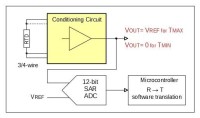RTD precision conditioning circuit with full scale adjustment

By exploiting the full dynamic range of a 12-bit or even 10-bit converter, you can make precise temperature measurements (e.g., resolution of 1/40°C or 1/10°C over a 100°C range) using this customized conditioning circuit, which also includes cable compensation.
In terms of precision, the RTDs are the best temperature sensors despite some limitations.
They suffer mainly from two intrinsic characteristics:
- at the minimum temperature to be measured, the resistance is far from zero.
- the drive current should be kept low (1mA max recommended) to avoid self-heating.
So, the sensor's usable output voltage is weak (a few tens of millivolts) and added to an offset of roughly the same order.
With an analog-to-digital conversion made by a delta-sigma converter, most often no front-end amplification is necessary thanks to the high resolution of such converters.
However, if the converter is a 12- or a 10-bit of the SAR type, amplification is mandatory, but if done in its simplest form much of the converter's dynamic range is unexploited due to the aforementioned zero offset, resulting in a significant loss of accuracy.
The following article (written in French) describes in detail the analog design of a conditioning circuit that solves this problem by enabling both ends of the desired temperature range to be precisely defined. And, of course, it also takes into account the compensation of 3- and 4-wire cables.
They suffer mainly from two intrinsic characteristics:
- at the minimum temperature to be measured, the resistance is far from zero.
- the drive current should be kept low (1mA max recommended) to avoid self-heating.
So, the sensor's usable output voltage is weak (a few tens of millivolts) and added to an offset of roughly the same order.
With an analog-to-digital conversion made by a delta-sigma converter, most often no front-end amplification is necessary thanks to the high resolution of such converters.
However, if the converter is a 12- or a 10-bit of the SAR type, amplification is mandatory, but if done in its simplest form much of the converter's dynamic range is unexploited due to the aforementioned zero offset, resulting in a significant loss of accuracy.
The following article (written in French) describes in detail the analog design of a conditioning circuit that solves this problem by enabling both ends of the desired temperature range to be precisely defined. And, of course, it also takes into account the compensation of 3- and 4-wire cables.



Diskussion (0 Kommentare)